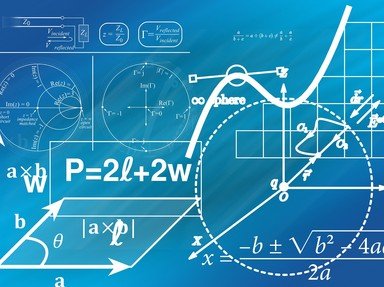Quiz Answer Key and Fun Facts
1. I'll start by warning all those math die-hards who want everything with mathematical precision that I am cutting corners big time so don't get upset.
Until we had complex numbers, we were quite happy with the numbers we had. These were called:
2. I hear you say "why do we need those stupid numbers". We'll come to that later, first let's talk about "how" we do them. Since all numbers were covered by the ten digits we already knew, we needed another unit. We call this unit "imaginary" and represent it by the letter "i". What does "i" stand for in terms of non-complex (real) numbers? (Hint: if you have a calculator, use it).
3. To make a complex number is easy: you just add the imaginary "i" part to the real part. Most complex numbers take the form "a real number plus an imaginary part" where the imaginary part is a couple of "i"s. Which of the following are valid complex numbers?
4. So you see, a complex number z has a real amount called Re(z) and an imaginary amount called Im(z). Just to check if you are with me: what is the imaginary part Im(z) of 5 + 4*i
5. Now about the why: this might sound silly to you, but complex numbers make life easier for mathematicians and are easy to work with. For example: mathematicians like smooth rules like "a polynome of degree n has n roots".
To explain this, try to figure out these two :
If x - 1 = 0, what is x
and
If x^2 (that's x squared: x*x) - 1 = 0, what is x?
(Hint: fill in the answers and see what happens)
6. If you haven't given up by now: bravo! If you get this one right you know your complex numbers already. What is/are the solution(s), called root(s), of x^2 + 1 = 0?
7. If you are happy that you understand it until now, you are absolutely right! If you want, you can stop now, but if you've made it this far, you might want to continue; it could be interesting to find out how to visualize a complex number.
Take a piece of paper and draw a big cross, like a big "+". from left to right we put the real part of a complex number and from bottom to top the imaginary part.
In the middle of the "+" is the 0 for both. 1 is right of the "+", - 1 is left of the "+", i is in the direction of top, - i is going down. Where do you think would 1 + i be?
8. This is the fun part: detecting complex numbers in real life.
Take a look at a bicycle wheel. Attach something on the tyre (a piece of duct tape for example) or mark it in any other way. Now look at it from the side and give it a spin. If you imagine that the hub of your wheel is the middle of the real-line-imaginary-line cross, how would you describe the movement of your marker?
9. Again put a marker on the rim of the bicycle wheel and give it another spin. If you look at the same wheel from above now (so that you only see the tyre but not the spokes), what kind of movement is your marker making?
10. If you never heard of complex numbers before but had no problems with this quiz, you have missed your calling. Please report to the next engineering school immediately.
For extra credit, especially those mathematicians who were getting really bored. In my field, electrical engineering, we don't use "i" but "j". Why is that?
Source: Author
triviapaul
This quiz was reviewed by FunTrivia editor
crisw before going online.
Any errors found in FunTrivia content are routinely corrected through our feedback system.
